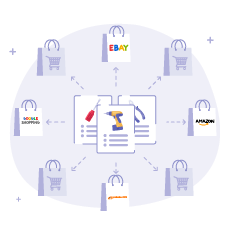Spaghetti and meatballs. Rest and Relaxation. Lennon and McCartney. Some things are perfectly fine on their own, but are truly at their best when work...

Table of Contents
Keywords
Still don’t believe that PIM and Syndication go together like two peas in a pod? Read on to find out what syndication is, why the pair combine to create such a dynamic duo, and how Akeneo helps you harness their combined powers to create a great product experience across each and every one of your sales channels.
There are two types of sales channels where brands and manufacturers sell their products: owned and unowned sales channels. Owned channels are those that you control: your eCommerce site, your print catalog, your physical stores. Unowned channels are defined and run by someone else: this includes marketplaces like Amazon or Alibaba, social media platforms, and comparison sites like Google Shopping.
Generally speaking, syndication platforms enable you to publish a unified (but not uniform) product experience that remains as consistent as possible across your unowned sales channels. More specifically, best-in-class syndication platforms:
If you are seeking to be present on many marketplaces that each have specific product listing requirements - and they all do - then a syndication platform can be a useful tool for managing those feeds and keeping your product listing compliant with marketplace requirements.

So, now that we know what Syndication is and what Syndication platforms do, it’s time to take a closer look at exactly what makes PIM and Syndication such a dynamic duo.
Some syndication platforms offer embedded PIM capabilities. But there is a very good reason why it makes sense to consider them separately. If you are selling primarily on owned channels, syndication isn’t necessary. PIM tools like Akeneo allow you to enrich and configure your product information for use in your owned channels and offer API-based connectors to eCommerce platforms as well as print channels where syndication isn’t needed. And as you add unowned channels, the product requirements are different. By decoupling your architecture to use both a PIM tool and a syndication platform, you can insulate each channel from the complexity and change happening in another, while keeping your core product information complete and consistent. This will deliver greater agility and reduce errors in your product listings across your different sales channels.
So what is it about these two that allows them to elevate your product experience management practice? The answer lies in a PIM solution’s ability to elevate the utility and value of syndication platforms. A syndication platform can be dangerous without a PIM — the last thing you want to do is syndicate poor quality, incomplete, error-laden product information to hundreds of channels! But when working together with syndication, PIM ensures brands and merchants can create an experience that is consistent across a wide range of channels but remains dynamic by complying with and taking advantage of the rules and properties for each sales channel.
As we say here at Akeneo, there’s no one product experience to rule them all. In other words, it’s impossible to deliver the same experience, or even similar experiences, via both a voice assistant and a social network, for example. Instead, omnichannel commerce requires you to create a unique and tailored experience for each channel in order to resonate with customers. Syndication platforms help you accomplish this by making it easier to send the right data to the right channel in the blink of an eye, ensuring that your customers are greeted with a dynamic yet consistent experience across your many sales channels.
To truly take advantage of all that syndication has to offer, you need the right PIM solution. That’s where Akeneo comes in. Akeneo’s best-in-class PIM solution gives you the tools you need to create accurate, consistent, and dynamic product information. But that’s not all.
You also need a solution with a deep and wide network of partners to take your syndication skills to the next level, especially if you’re a brand or manufacturer looking to start selling direct to consumers via marketplaces like Amazon or industry-specific marketplaces. Fortunately, with Akeneo’s team of more than two dozen technology partners, including syndication partners like Productsup and Lengow, you can find the right solution to help you syndicate your enriched product data to a wide range of sales channels with relative ease. The Akeneo Marketplace offers several extensions to help you and your team find the perfect syndication platform to strengthen your PIM and build the best product experience management practice around.
So if you want to help create the next dynamic duo, pair syndication with Akeneo PIM and discover why they truly are a match made in heaven.
Want to learn more about Akeneo PIM and syndication? Request a demo!